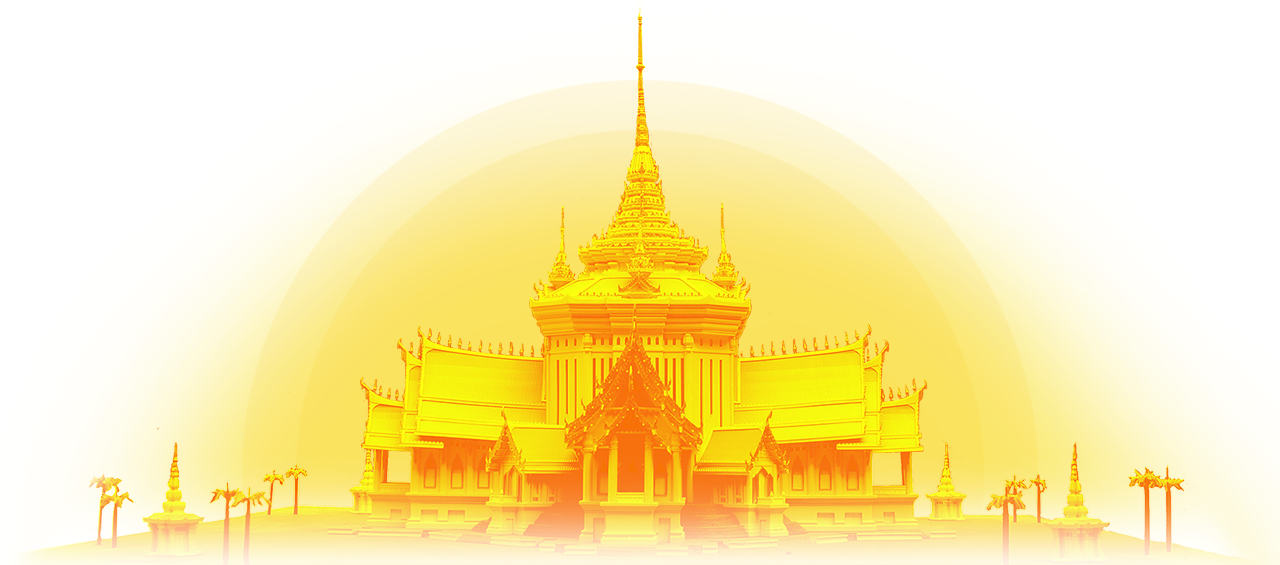- Home
- Dhammakaya%2520meditation
- Questions & Answers
Where is the center part of the body?
The way to locate the center part of your body is to imagine two transparent strings or lines. One line passes from the front to the back, two “anguli” (middle finger joint lengths) or about two inches or five centimeters above the navel level. Visualize that line. The second line passes from the middle of the right side to the left. Now you can see the intersection of the two lines. That is the center of your body.
Do you see the bright shere up here, near the eyes, or down here, at the center of your body?
It should be at the center of your body. This is the most proper place. I know that many people may see the bright sphere on the forehead or outside. Try to bring it in to the center of your body. The technique for bringing your mind in is to roll your eyes upwards a little bit while gently closing your eyelids. This helps the mind components which are wandering outside to go backwards and vertically downwards, coming to rest at the center of your body. Try it. Roll your eyes upwards and imagine the center of your body, then the bright sphere will appear there.
Could you please tell that gentleman not to take photographs during meditation session? the flashes distract my concentration.
That can be a problem, but you must learn through experience to separate your mind from the outside environment. Even if the fan goes tick, tick... or you meet other disturbances, don’t worry about them. Don’t pay any attention to them. When you pay attention to your object of concentration and nothing else, your mind will be free and will stop still in the proper place. It is your mind that you wish to train. Try it.
Did not actually see the bright sphere when I closed my eyes. But, when I was breathing in and out I was concentrating on the breath and then I could get a white light. What do you think about this?
That’s good. This method can also incorporate anapanasati. Anapanasati is mindfulness of breathing, without following the breath. Don’t follow the breath, but be mindful of it at any one of several fixed points that the breath passes, like at the nostril aperture, the center of the chest, or at the center of your body. If you do Anapanasati properly, you will find your breathing becomes shallower and shallower, more and more refined. Eventually, it will stop still at the center of your body and you will see a very bright sphere there. This is the objective of Anapanasati in the Dhammakaya approach. The mind will stop naturally, by itself. Then, you have come close to the right track. When you observe the breathing, your mind will become better and better concentrated, even though your mind has not yet stopped still at the center. When your mind stops at the center of your body, you will see the light sphere there. Your mind should be still there. Try again. If you are used to Anapanasati practice [Mindfulness of Breating], just imagine a sphere at the center of your body and be mindful of it. When you breathe in and out, put your mindfulness there. Observe your breath passing through the sphere. Then, you will see the sphere getting clearer and clearer. When your mind stops still at the center of the sphere, you will find light. You will appear not to be breathing because the breath has become very shallow and refined. When your mind stops still, you will see a very bright sphere or nucleus as your object. Be mindful there.
Just now, when you said to imagine the sphere, I couldn't really see or visualize the sphere. What should I do?
Try more. This is the first time you are trying to train the mind which has been wandering outside ever since your were born. You require a longer time to train it to stay at the center. Don’t be over eager to see something. When a light appears, you may press your mind hard to see a sharp image of a sphere. If so, the light may disappear. Just relax. Don’t pay attention to anything but the center of the object of concentration. Don’t be too eager, just visualize the sphere. Stop still at the center of the center, repeating the words “Samma Arahang”. Try to practice today before going to bed or whenever you can. You can practice in any position: walking, sitting, eyes opened or closed, it doesn’t matter. Just bring your mind into the center of your body. This is very meritorious. Why? When your mind wanders outside, it will contact and attach to worldly objects you like, or feel aversion towards the objects you dislike. That will cause passion to arise in the form of craving, greed, ill will, or delusion. So, if you bring your mind inside, even for a second, it is very meritorious because the mind stops unattached to any worldly object. Thus, your mind will become purer and purer. Try to do it everyday, every time you feel free to do so, in any position and at any place.
Reverend, when you see the sphere, isn't it supposed to be round? I see something which looks oblong.
Yes, it may be so, but do not be bothered at all. If you stop still at the center (a very transparent spot), you see Dhamma. The Dhamma Sphere enlarges from that spot and becomes a sphere anyway.
You said to imagine the center of the sphere at the nose aperture, then the eye socket, then the center of the head. Why those positions?
Luang Phor Wat Paknam, who originally taught the Dhammakaya approach, during his time, discovered that the mind of a person functions in this way when he or she is about to die, to fall asleep, to wake up, or to be reborn. The old mind at the center of the Dhamma sphere in the seventh position will drop to the sixth position, in line with the navel. Then, the new mind of the new body (which depends on kamma) will rest at the seventh position. That is why we call the center of the body the permanent place of the mind. When exiting, the mind drops to the sixth place, then fifth, fourth, third, second, and first. Then, out it goes. Similarly, the mind enters by the same path. So, for the first meditation session, we are instructed by Luang Phor Wat Paknam to teach all students to know the path along which the minds gets in and out. This occurs when a person dies, is reborn, falls asleep, or awakens, or even during other activities not mentioned here. This initial technique is for you to know how the mind gets in and out. Afterwards, for subsequent meditation sessions, we will advise you to immediately concentrate at the center of the body. Why? Within the physical body, more and more refined bodies exist along with Dhamma and mind. As you know, the mind components are feelings (Vedana), perception (Sañña), formations (Sakhara), and consciousness (Viññana). These elements develop to be the four mind components: the Sphere of Vision, the Sphere of Memory, the Sphere of Thought, and the Sphere of Awareness. All these are naturally positioned at the center of the body. Here, at the center of the body is where you can contemplate the four Foundations of Mindfulness or Satipathana. These Satipatthana were cited by the Buddha as “the only way” to enlightenment, regardless of which approach you take. In Satipathana practice, one is mindful of and contemplates refined bodies, feelings, mental functions, and phenomena (dhamma) both externally and internally. This is done most efficiently at the center of the body, through the Dhammakaya Meditation, because all the more and more refined bodies, minds and phenomena (dhamma) inside us are located at the center of each other. When you stop still, your mind becomes purer and purer. You can reach more and more refined Dhamma and purer and purer minds and bodies until you reach the purest Dhammakaya. Dhammakaya is the purest state of mind and has different characteristics from Sangkhara or compound nature. Moreover, as your mind becomes purer and purer by stopping still at the center of the center of purer and purer Dhamma, mind and bodies, what happens? Nothing outside can disturb you.
Can we say that a longer time, say a month, would increase the success rate to 50%?
No, I cannot say that. It may be 40% or even less, because usually fifteen days is the maximum for a person to continue exerting his or her whole effort. Longer than that and the meditator might become bored. You need a rest.
It cannot be like three months?
Seriously, it doesn’t help much. It should be about fifteen days. After that, relax a little bit, then proceed again. In that way you’ll have progress.
How long does it take to see the crystal ball or Pathamagga?
It depends upon each person’s capability. There are many factors. First, is former kusala kamma (meritorious deeds); second, present kusala kamma from trying to follow the Master’s teachings. For example, meditators have to accept the precepts and try to keep mindful of the sphere by repeating the words “Samma Arahang.” Practice it often. Don’t let wrong emotions such as losing your temper develop in the mind. Try to calm the mind. Be mindful all the time and practice often, using the right method.
So, if you attend the fifteen-day retreat in Rajburi, what is the possibility of being successful in seeing the crystal ball?
I would say a third of the participants are successful, if they complete the fifteen days. At least you can more or less see the sphere.
When I am meditating, my attention seems to be concentrated mostly on all the arising spheres and bodies. When will I have the possibility to contemplate and and when I can develop that all important wisdom?
Any time the mind is free from the five hindrances, you can go on contemplating. For example, when you see the sphere clearly, you can enlarge it at will, which would then mean that your Sphere of Vision, Sphere of Memory, Sphere of Thoughts, and Sphere of Awareness would be larger too. Just go on until it is about the size of your whole body. In that state, supernatural vision will be developed, enabling you to observe all angles of your body simultaneously. In other words, you do not have to move your vision from place to place to see at all. You can now contemplate on every organ of your body until you fully realize that not one single part is attractive, but all organs are in fact impure. This is also a very effective way to calm down your mind from sexual desire. I will give you an example. When I was still a layman I took a com-muter pickup bus (song taew) home. I was lucky to get a seat, but as the bus filled there was standing room only and people stood very close. A young lady stood right in front of me, facing me, and her bosom was at times touching my face as the bus swayed. I was concentrated all the time, and in my mind I intended to see what she looked like. During the ride I saw every part of her body that I wished to see, and I then realized that it was in fact very dirty. She had her period and a rather unpleasant odor hit my mind at that point. So, that was contemplation of the human body (Kayagatasati), and I have used that technique ever since, both on my own body and those of others. It also helped me in staying away from my spouse for ten years prior to my ordination as a monk. When you get a sexual feeling, be mindful right away. Use your wisdom, and start contemplating as soon as you get rid of the hindrances. Purify yourself from the crude mind up to more and more refined minds. When you reach the purest, the most calm, contemplate! You will calm down any sexual desire by seeing the reality of all organs. Be mindful all the time!
Would I ever be able to look into the future during meditation?
Any time the mind is free from the Five Hindrances, you can go on contemplating. For example, when you see the sphere clearly, you can enlarge it at will, which would then mean that your Sphere of Vision, Sphere of Memory, Sphere of Thoughts, and Sphere of Awareness would be larger too. Just go on until it is about the size of your whole body. In that state, supernatural vision will be developed, enabling you to observe all angles of your body simultaneously. In other words, you do not have to move your vision from place to place to see at all. You can now contemplate on every organ of your body until you fully realize that not one single part is attractive, but all organs are in fact impure. This is also a very effective way to calm down your mind from sexual desire. I will give you an example. When I was still a layman I took a com-muter pickup bus (song taew) home. I was lucky to get a seat, but as the bus filled there was standing room only and people stood very close. A young lady stood right in front of me, facing me, and her bosom was at times touching my face as the bus swayed. I was concentrated all the time, and in my mind I intended to see what she looked like. During the ride I saw every part of her body that I wished to see, and I then realized that it was in fact very dirty. She had her period and a rather unpleasant odor hit my mind at that point. So, that was contemplation of the human body (Kayagatasati), and I have used that technique ever since, both on my own body and those of others. It also helped me in staying away from my spouse for ten years prior to my ordination as a monk. When you get a sexual feeling, be mindful right away. Use your wisdom, and start contemplating as soon as you get rid of the hindrances. Purify yourself from the crude mind up to more and more refined minds. When you reach the purest, the most calm, contemplate! You will calm down any sexual desire by seeing the reality of all organs. Be mindful all the time!




